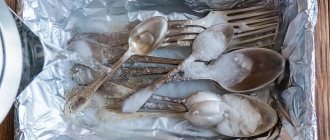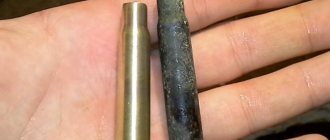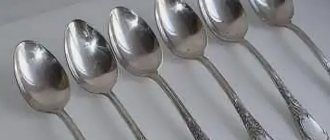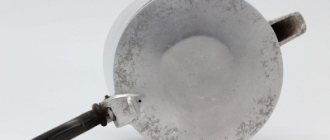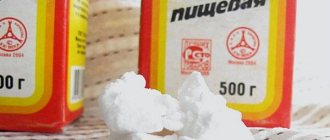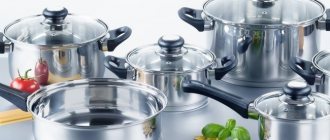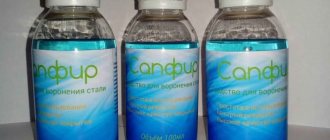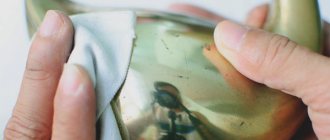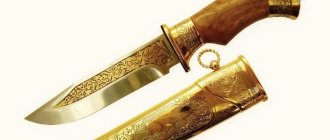High-quality forged serving sets made of cupronickel are valued on a par with silver. Ductile metal lends itself well to processing; real works of art are created from it. Over time, an exquisite design becomes overgrown with blackness, the alloy fades, and loses its former splendor. The review contains the best methods to help clean cupronickel spoons and forks at home. Products that can be found in every kitchen or medicine cabinet will help restore your dishes to their former appearance. Folk remedies have been tested for years and can be trusted.
Cutlery is an important part of a perfect table setting.
Why does cupronickel darken?
Why do cupronickel spoons and forks darken? This can happen for various reasons:
- due to storage of such utensils in unsuitable conditions;
- high humidity in the room;
- improper care of such products.
In such cases, moisture accumulates on the surface of the product, which subsequently leaves dark spots and streaks. Fortunately, with proper cleaning, they can be easily and quickly removed using both special means and folk recipes.
How to clean cupronickel silver cutlery
There are specific techniques based on the chemical properties of the components of cupronickel.
Dark plaque is difficult to remove:
- from the drawing on the handles of serving utensils:
- in the space between the tines of the forks.
Dark plaque is the main problem with cupronickel products.
Boiling and soaking are used. If you know how to clean cupronickel silver cutlery at home, you will enjoy your dishes for many years.
Soda
To clean cutlery, soda is used in several ways:
- Apply the paste onto a non-woven cloth and wipe the darkened areas;
- make a warm solution at the rate of 3 tbsp. powder per liter of water, immerse table cupronickel for 2 hours, old stains will disappear, the relief pattern will be renewed;
- add 1 tbsp to the boiling solution. l per liter of water, then immerse the devices in boiling water for 10–15 minutes.
You can also try cleaning dark spots and deposits on appliances as a result of careless use for a long time using baking soda.
Alcohol
Use alcohol to remove stains on a smooth surface. Soak the cotton pad well, hold it briefly on the metal, then rub the dishes until they shine.
The alcohol can be anything: medical ethyl, formic, camphor.
Garlic peel
In ancient times, housewives used improvised means. At home, cupronickel utensils were boiled in garlic peels. You will need a lot of it - it should completely cover the bottom of the wide container.
Instead of husks, pipes left after harvesting garlic from the garden are suitable.
Plant materials are loaded into a large container, and serving items are placed on top in one row. Fill with water so that all the metal is covered. Place the container on the fire, bring to a boil, and leave until it cools completely. After this, cupronickel is washed with a sponge and detergent or dry mustard.
Eggshell
An ancient folk method that was used in merchant houses for cleaning household utensils made of silver, cupronickel, and copper. The shells are boiled with salt for 20 minutes (add 2 tablespoons to 1 liter of water). Objects are dipped into the boiling liquid for 2-3 minutes. After this, rinse the dishes and wipe dry with wool or flannel.
The darkening will disappear, the relief on the handles will become clean.
Ammonia and vinegar
Ammonia is a long-known cleaner. Vinegar is a popular solvent. Both of these liquids are used to clean cupronickel. Add to water when washing or wipe with a moistened cotton pad.
The method is suitable for silver and gold plated cutlery.
Potato broth
If you wash the root vegetables well before peeling them, the peelings can be used for household purposes. The decoction is used to clean cupronickel tableware; spoons and forks will become like new. The peel is boiled for 20 minutes, then the serving items are immersed in boiling water.
After 2 hours, just rinse and dry them.
Lemon acid
If products are stored for a long time, they become covered with a dark layer of oxides. The alloy can be easily cleaned with citric acid or a slice of lemon.
The maximum concentration is like vinegar - 9%.
Important! The solution must be cold. The metal reacts with hot food acids.
Special means
Important! When choosing household chemicals, you need to study the chemical composition. Cupronickel will be irrevocably damaged by compounds with chlorine. It is better to avoid chlorine-containing products, even if it is written that they are intended for cleaning cutlery.
It is convenient to clean cupronickel with gels and cream pastes; they linger on the surface and do not run off. If the label indicates that the product is for cupronickel, you can safely use it.
Household chemicals for cleaning silver are also suitable.
Popular formulations:
- gel "Sif";
- emulsion "Amethyst";
- Polymet paste.
It is better to put cleaning powders aside. You can maintain the appearance of the dishes with special products for jewelry; they are purchased in specialized stores for jewelry.
Specialized products are chosen for cleaning cupronickel products.
Method 1 - special cleaning products
How to clean cupronickel coins and kitchen utensils? It is best to use specialized products for this purpose that do not harm the metal, but are good at removing any darkening. Such products are produced in the form of special cleaning wipes, as well as powders, pastes, and sprays. In most cases, it is enough to apply such products to cutlery or coins and wipe them well to remove any deposits.
Important: when choosing professional products for cleaning cupronickel, give preference to those that not only remove dark deposits, but also form a protective film on the dishes. They will allow you to forget about this problem for a long time.
Nuances of cleaning
Cupronickel silverware must be cleaned periodically to restore its original shine. The origin of dark spots can be partly explained by violation of the rules of care and storage:
- A dishwasher was used to wash the products.
- The items were stored together with utensils made from another metal. This should not be done so as not to contribute to the accelerated oxidation process.
- Washed spoons, knives, forks and other items must be thoroughly dried and kept in a closed container, preventing access to moisture. It leads to the appearance of brown stains.
- If cutlery was not washed properly, food particles could remain on them. Getting into small scratches on the surface of products, they provoke the appearance of dark spots.
- Treatment of cupronickel silverware with chlorine-containing agents and abrasive compounds causes oxidation of copper, which is part of the alloy. Even chlorine vapor can harm sensitive metal.
Nickel silver sets can be cleaned, but this must be done correctly, taking into account a number of mandatory requirements. Violation of processing technology leads to irreversible damage to items.
- Copper-nickel alloy is very delicate, easily damaged, and requires careful handling. Do not rub the material with sandpaper, metal sponges or abrasive agents, including sand.
- Cupronickel should be cleaned with a piece of suede; the material not only carefully removes dirt, but also perfectly polishes the metal to a shine.
- Before you start cleaning, items must be washed thoroughly in warm water with washing liquid to degrease.
- Do not use very hot water when washing or rinsing items.
- When cleaning is complete, all utensils should be thoroughly washed and dried. It is advisable to first lay the product on a dry cloth, and then dry it additionally with a towel.
- Cupronickel silver items with stone trim are not cleaned with ammonia. By breaking this rule, you can damage the decorative element or remove the adhesive layer that holds the stone.
Rubber gloves will provide protection to the skin of your hands when using chemicals to process cupronickel.
Do not use abrasive sponges or sandpaper for cleaning
Suede gently removes dirt without damaging the surface
Before cleaning, wash cutlery with detergent.
After cleaning the spoon, wipe it dry
Cupronickel silver items with stone trim are not cleaned with ammonia
Method 2 – baking soda
How to quickly remove dark deposits from cupronickel dishes? This can be done using ordinary baking soda. If the products have darkened not so long ago, all you need to do is put a small amount of soda on a cloth and wipe all the products well with it.
If the dark coating from the dishes is difficult to remove, you can treat it with soda in a different way. They do it like this:
- Take a small piece of foil and line the bottom of the pan in which the cutlery will be cooked.
- After this, add 4 tablespoons of soda to the pan. Then they place on the bottom the cupronickel dishes that need to be put in order.
- Next, you just need to pour boiling water over the products and leave them in the water for a few minutes. During this time, the dark layer will come off completely.
- If the dirt on the knives, forks, and spoons is very strong, you can put a saucepan with them on the fire and boil them for 15 minutes. This is guaranteed to rid the product of any dark plaque, even very old ones.
Important: never use this cleaning option for gold or silver plated items. The beautiful coating will come off completely in this solution.
Chalk polishing
The most common chalk can be used to polish cutlery items to a shine and remove minor dirt from them.
Polishing procedure:
- Grind the chalk into powder;
- Add a little water until you get a viscous slurry;
- We take a soft cloth (without lint) and apply the mixture on it, with which we polish the products.
If you don’t have chalk, then a non-abrasive toothpaste with silicon oxide in its composition is great for these purposes. It is applied to a damp cotton pad and can be used to clean nickel silver spoons, forks and knives.
Method 4 - ammonia
Darkened cupronickel can be easily cleaned using ammonia solution. You just need to soak the products in it for a few minutes, after which they will need to be taken out, rinsed under running water and wiped especially thoroughly. There will be no trace left of the dark coating.
You can also use this product in another way: just put a small amount of ammonia on a cloth and thoroughly wipe the spoons and forks with it. In just a few minutes of work, ammonia will completely remove any dark stains from your appliances.
Decoctions for cleansing
You can also prepare special cleansing infusions. This is another wonderful folk remedy that will help you cope with even the most severe stains.
Suitable for preparing the decoction:
- Garlic peel;
- Potato.
Potato broth is considered less effective, but the most gentle. It does not harm the surface of products, so you can safely use it for items with gold or silver inserts.
A decoction of garlic peels is prepared as simply as possible. The husk needs to be boiled, and the more of it, the better the broth will cope with darkened spots.
Thus, you can restore the former sparkling appearance of cupronickel accessories in different ways, without spending money on additional cleaning products. The main thing is to take care of such items in a timely manner , to prevent water from getting into the places where they are stored, then they will always be in excellent condition.
Method 5 – potato broth
This is another simple recipe for cleaning cupronickel products at home. For it, you will need to take a potato decoction, bring it to a boil, put the products there and leave for 20 minutes.
After this, you will need to carefully remove the spoons and forks, rinse them thoroughly and wipe them dry. After this, plaque will not appear on them for a long time.
What can't you do to clean gold plate?
Any products used should not contain abrasive particles. Even the smallest particles can severely damage the spray. For example, you should not clean gold plate with chalk, toothpaste, soda or powder.
Any abrasive product will cause scratches.
Some products are coated with a very thin layer of coating; abrasives easily erase it. Do not use rough scourers or brushes, or aggressive acids for cleaning.
Method 6 – vinegar
If you need to quickly get rid of slight darkening, use vinegar. Apply it like this:
- Take a glass of water, add a teaspoon of table vinegar to it, mix everything thoroughly.
- Soak a cloth in the solution and run it over all dull cutlery.
- Rinse the products well in running water and rub them with a clean cloth.
Important: this cleaning method can be used quite often. It practically does not harm the metal.
How to save the result
Having achieved the desired result, a natural desire arises to consolidate it.
Traditional methods will help your serving items regain their former beauty.
There are at least 6 useful tips on how to do this:
- utensils should be stored in a special case to limit access;
- It is better to wrap devices that are not used often separately in paper and store them that way;
- if the products are used frequently, they should be washed with cold water (then darkening will occur much later);
- regular treatment with a bleaching compound;
- before eliminating darkening, you need to get rid of food debris;
- do not use chlorine in cleaning.
There are many polishes and chemicals for cleaning cupronickel.
Dishwasher safe. To avoid darkening, avoid joint machine washing with other metal products.
Method 7 – sodium thiosulfate
This is another inexpensive and very accessible means for cleaning cupronickel, which can be purchased at almost every pharmacy. It is used like this: a small amount of sodium thiosulfate solution is applied to the devices, and then thoroughly wiped with a cloth. After this, the products must be rinsed in running water and wiped dry.
Video: cleaning cupronickel cutlery until shiny:
Tip: use this method if you want to deal with a light dark coating. It will rid the products of it in a matter of minutes.
Features of the material
- Copper is found in minute quantities in human blood cells. It is found in many enzymes and is credited with antibacterial properties. The lack of this element disrupts metabolic processes and interferes with the normal development of bone tissue.
- Nickel accumulates in the parathyroid gland and pancreas. It promotes the oxidation of vitamin C, plays a role in maintaining stable glucose levels, and is therefore useful for diabetics. It also has a positive effect on hypertension.
- Water with cupronickel ions helps prolong youth and improve skin health.
Cupronickel silver cutlery has earned respect for its other advantages.
- The products cost much less than silver ones, but not everyone can tell the difference between the metals.
- Items are resistant to high temperatures.
- With proper care, forks and spoons, as well as other cupronickel utensils, will delight their owners with their shine for a long time.
- The products warm up slowly, so a spoon in hot tea will not burn a person if he drinks from it.
- The metal does not rust, and this is an important property for kitchenware.
- Cupronickel objects are very durable and difficult to bend, even with force.
Speaking about the advantages of the alloy, we should not forget about the existing disadvantages. The most important of these is susceptibility to oxidation. As a result, an unsightly dark coating quickly appears on cupronickel dishes, which has to be cleaned off. Items require special and regular care, which can be burdensome for some housewives. The second disadvantage: cupronickel is not so easy to find, it is produced in small quantities, and the products have already become antique.
Method 8 – eggshells
How to clean nickel silver so that it shines like new in just a few minutes? Use fresh egg shells for this purpose. Proceed like this:
- Grind the shells.
- Place a pan of water on the fire and add a tablespoon of table salt to it.
- Bring the water to a boil, add the eggshells to it first, and then the cutlery.
- Keep the devices in the solution for 15-20 minutes. During this time they should completely lighten.
Important: Do not use this recipe to clean silver. This metal will react to such influence differently than cupronickel.
Method 9 – toothpaste
Cupronickel silver cutlery can be cleaned very well with regular toothpaste. You will need to work with it like this: apply the paste itself on a cloth and wipe the cutlery with this cloth until they are completely free of dark stains. After this, the product must be rinsed.
Tip: instead of toothpaste, you can use regular tooth powder. It copes even better with various darkening.
Useful tips
Cutlery made from this alloy cannot be cleaned with hard sponges and various abrasives (dry soda, tooth powder). The surface of the alloy will be cleaned, but scratches will appear on it. They are almost invisible after the first cleaning, but after two or three procedures the products will lose their shine.
7 Helpful Tips for Cleaning Pots Without Scratching
Cutlery made of nickel silver and decorated with gold plating is carefully cleaned. First, the gold-plated surface is wiped with a dry cotton swab to remove dust. It is then treated with a cotton swab dipped in turpentine or wine vinegar. After this, the cutlery is carefully washed with water. It is also recommended to rub gold-plated devices with an egg white-based mixture. Instead of cotton wool, use a soft flannel napkin.
Nickel silver products with blackening require careful handling. They cannot be boiled in garlic, soda or saline solution, as the decorative blackened areas will become light and decorative. Such products should only be cleaned by hand using toothpaste, or even better, a special cleaning agent.
Cupronickel silverware and other items cannot be washed in the dishwasher. Do not use solutions containing chlorine for cleaning.
After completing the procedure, cupronickel cutlery is wiped dry. They are often stored in cardboard boxes or kitchen drawers. But you need to wrap the cutlery in cling film. This will block air access and slow down oxidation. This means that the surface of the devices will not darken. Remember that you cannot store nickel silver devices next to household chemicals or perfumes, even if the products are in a closed box. This accelerates oxidation processes.
Method 10 – crushed chalk
This is another fairly effective method that was previously used even by some jewelers. It is used like this:
- Dissolve 50 grams of soap in water, then dilute 50 grams of chalk in the same solution.
- Next, add another liter of water to the resulting mixture and mix everything until smooth.
- The resulting mass is used to polish the products, after which they are wiped dry with a cloth.
Important: make sure that the polishing compound is completely removed from the metal after use. Otherwise, it may leave white streaks on it and you will have to start cleaning all over again.
Video: an effective method for cleaning cupronickel and silver devices:
A little history
Cupronickel as such does not exist in nature: in fact, it is a group of compositions made of copper with the addition of nickel, iron, zinc, manganese and some other metals. Most often it is an alloy of copper and nickel, which has its own specific features and properties. According to historical sources, it was invented in China in the 8th century BC and given the sonorous name “pakfong”. All attempts to unravel the composition of “Chinese silver” by European alchemists were unsuccessful: only by the beginning of the 19th century did mass production of nickel silver begin in Germany. At first, the European nobility considered such dishes to be “the dishes of the poor,” and therefore still preferred dishes made of other metals - gold and silver. Only by the 20th century did production increase its speed everywhere. The attractive appearance of cupronickel was used to make cutlery, candlesticks, jewelry and other decorative elements. Wear-resistant, easy to maintain and not too expensive, the alloy is appreciated and actively used in household use.
Interestingly, psychologists consider cupronickel tableware to be beneficial for the psyche. The unobtrusive, calm, noble shine of the alloy calms the nervous system, relieves tension and sets you to a calm rhythm.
Method 11 – ultrasonic washing device
How to clean cupronickel spoons if you don’t have any household chemicals on hand for this purpose? Use an ultrasonic washing device for this purpose. To do this, just take a small bowl, fill it with water, put spoons and forks in it, then place an ultrasonic cleaner in the bowl and let it work for a quarter of an hour.
This method can be used even for those devices that have not been cleaned for a very long time. It copes well with the most stubborn stains.
How to restore shine
Spoons made from cupronickel became an original replacement for various silver items. In order for such products to be no different, they must shine well. There are several methods for cleaning cupronickel spoons and forks at home, which make the product sparkle like real silver.
To make the spoons shine again, white chalk is used. To obtain shine, you need to make a solution consisting of several ingredients:
- Water – 1 liter;
- Crushed chalk - 2 tbsp;
- Planed soap - 2 tbsp.
Use this mixture to polish the cupronickel spoons well. For work, you can use rags, a soft cloth will do. As a result, all spoons will return to their original appearance.
Pasta
A very unusual technology for cleaning cupronickel. Pasta is thrown into the boiling liquid. When they are cooked, kitchen items are dipped into them. We need to ensure that they sink to the bottom. Wait 20 minutes. This method perfectly restores shine. Eating pasta after the procedure is strictly prohibited. They need to be thrown away.
Foil
Any metal container can be used. A metallized sheet is laid at the very bottom. Water is poured, soda is added in compliance with the proportion: one liter - 2 tablespoons of soda. Cutlery is immersed in the solution, the container is placed on the stove, and a moderate flame is set. In five minutes the darkness will disappear. All that remains is to take out the items and wipe them well. To clean, you only need to use baking soda. Caustic cannot be used.
Toothpaste or powder
Ordinary toothpaste cleans precious items perfectly. It also perfectly cleans cupronickel silver spoons and forks. The surface is thoroughly wiped with a soft cotton pad. The work must be done carefully and patiently. The most difficult items to clean are those with complex designs and all kinds of openwork interpretations.
Toothpaste is an excellent substitute for toothpowder, which is pre-diluted in water to achieve a soft consistency. Cotton swabs, previously soaked in this powder, are used to process the smallest details.
How to care for cupronickel so that it does not darken
It’s not enough to figure out how to quickly clean cupronickel. It is also necessary to ensure that products made from it do not darken for as long as possible. To do this, you should follow the following rules for handling such metal:
- Store it only in places where chlorine-based products cannot reach.
- Wash products made of this metal only in non-hot water.
- Always wipe cupronickel silver spoons, forks, and knives dry. Never put them away for storage if such devices are still even slightly damp.
If you follow these recommendations, your nickel silver products will have to be cleaned extremely rarely. You can completely forget about using special tools for this.
Video: sparkling spoons in minutes:
How to clean nickel silver jewelry with stones
Corals, pearls and turquoise are considered the most delicate and capricious in matters of care. They do not tolerate foam, hot and soapy water, alcohol at all, and vinegar can completely dissolve pearls. For such products, only one product is ideal - salt.
- Let's make a strong saline solution without heating the water.
- Place your nickel silver jewelry in well-salted water and take it out after 2 hours, rinse thoroughly and wipe dry.
- And if after such a procedure you cover the turquoise with a thin brush with a small layer of animal fat, then it will perfectly retain its original appearance.
Amber, moonstone, opal, and malachite do not like humidity, but they wash well in soapy water to which an ammonia alcohol solution has been added. Then they are quickly rinsed and wiped with an absorbent and soft cloth. Ammonia will not harm a cupronickel alloy either.
